Related Research Articles

A utility knife is any type of knife used for general manual work purposes. Such knives were originally fixed-blade knives with durable cutting edges suitable for rough work such as cutting cordage, cutting/scraping hides, butchering animals, cleaning fish scales, reshaping timber, and other tasks. Craft knives are small utility knives used as precision-oriented tools for finer, more delicate tasks such as carving and papercutting.

A postage stamp is a small piece of paper issued by a post office, postal administration, or other authorized vendors to customers who pay postage. Then the stamp is affixed to the face or address-side of any item of mail—an envelope or other postal cover —which they wish to send. The item is then processed by the postal system, where a postmark or cancellation mark—in modern usage indicating date and point of origin of mailing—is applied to the stamp and its left and right sides to prevent its reuse. Next the item is delivered to its addressee.

An envelope is a common packaging item, usually made of thin, flat material. It is designed to contain a flat object, such as a letter or card.
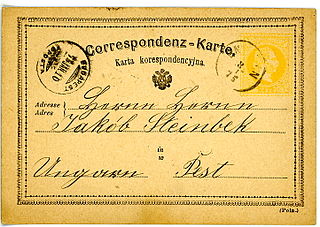
Postal cards are postal stationery with an imprinted stamp or indicium signifying the prepayment of postage. They are sold by postal authorities. On January 26, 1869, Dr. Emanuel Herrmann of Austria described the advantages of a Correspondenz Karte. By October 1, 1869 the world's first postal card was produced by Austria-Hungary. They caught on quickly. By the end of 1870, Great Britain, Finland, Switzerland and Württemberg joined the countries issuing postal cards. In the United States, they were first produced in 1873. Some of the forms taken by postal cards include the regular single card which may be commemorative or definitive, attached message-reply cards, airmail postal cards, and official postal cards used for official government business with a "penalty for private use".

For postage stamps, separation is the means by which individual stamps are made easily detachable from each other.

A piece of postal stationery is a stationery item, such as a stamped envelope, letter sheet, postal card, lettercard, aerogram or wrapper, with an imprinted stamp or inscription indicating that a specific rate of postage or related service has been prepaid. It does not, however, include any postcard without a pre-printed stamp, and it is different from freepost for preprinted cards issued by businesses. In general, postal stationery is handled similarly to postage stamps; sold from post offices either at the face value of the printed postage or, more likely, with a surcharge to cover the additional cost of the stationery. It can take the form of an official mail issue produced only for the use of government departments.
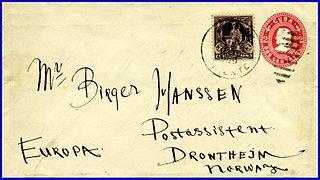
A stamped envelope or postal stationery envelope (PSE) is an envelope with a printed or embossed indicium indicating the prepayment of postage. It is a form of postal stationery.
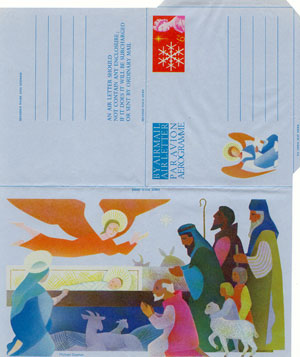
An aerogram, aerogramme, aérogramme, air letter or airletter is a thin lightweight piece of foldable and gummed paper for writing a letter for transit via airmail, in which the letter and envelope are one and the same. Most postal administrations forbid enclosures in these light letters, which are usually sent abroad at a preferential rate. Printed warnings existed to say that an enclosure would cause the mail to go at the higher letter rate.
A die is a specialized machine tool used in manufacturing industries to cut and/or form material to a desired shape or profile. Stamping dies are used with a press, as opposed to drawing dies and casting dies which are not. Like molds, dies are generally customized to the item they are used to create.
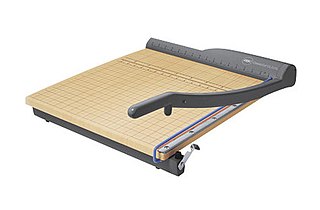
A paper cutter, also known as a paper guillotine or simply a guillotine, is a tool often found in offices and classrooms. It is designed to administer straight cuts to single sheets or large stacks of paper at once.

Die cutting is the general process of using a die to shear webs of low-strength materials, such as rubber, fibre, foil, cloth, paper, corrugated fibreboard, chipboard, paperboard, plastics, pressure-sensitive adhesive tapes, foam, and sheet metal. In the metalworking and leather industries, the process is known as clicking and the machine may be referred to as a clicking machine. When a dinking die or dinking machine is used, the process is known as dinking. Commonly produced items using this process include gaskets, labels, tokens, corrugated boxes, and envelopes.

Knife making is the process of manufacturing a knife by any one or a combination of processes: stock removal, forging to shape, welded lamination or investment cast. Typical metals used come from the carbon steel, tool, or stainless steel families. Primitive knives have been made from bronze, copper, brass, iron, obsidian, and flint.
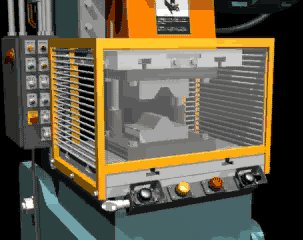
Stamping is the process of placing flat sheet metal in either blank or coil form into a stamping press where a tool and die surface forms the metal into a net shape. Stamping includes a variety of sheet-metal forming manufacturing processes, such as punching using a machine press or stamping press, blanking, embossing, bending, flanging, and coining. This could be a single stage operation where every stroke of the press produces the desired form on the sheet metal part, or could occur through a series of stages.

J. Murray Bartels was a New York City-based dealer and auctioneer of rare postage stamps. He was also well known for his knowledge of United States postal stationery.
Prescott Holden Thorp, of New Jersey, was a stamp dealer who was a recognized world-famous expert on stamped envelopes of the United States.

In philately, an imprinted stamp is a stamp printed onto a piece of postal stationery such as a stamped envelope, postal card, letter sheet, letter card, aerogram or wrapper. The printing may be flat upon the surface of the paper, or embossed with a raised relief. An imprinted stamp is also known as unadhesive stamp or indicium.

In philately a cut-out is an imprinted stamp cut from an item of postal stationery such as a postal card, letter sheet, aerogramme or wrapper that may have been used as a normal stamp.

In philately a wrapper is a form of postal stationery which pays the cost of the delivery of a newspaper or a periodical. The wrapper is a sheet of paper, large enough to wrap around a folded or rolled newspaper and with an imprinted stamp to pay the cost of postage. Some catalogs and reference books refer to a wrapper as postal bands which comes from the French term bandes postale. Still others refer to it as a newspaper wrapper or periodical wrapper.
The United Postal Stationery Society (UPSS) was formed July 1, 1945 from the merger of the Postal Card Society of America, in existence since 1891, and the International Postal Stationery Society, founded 1939. Current membership stands at about 1,000. The organization's journal since 1949 is called Postal Stationery. Articles appear about new issues of U.S. and international postal stationery, plus articles on rare and unusual stationery.

The term earliest reported postmark or ERP is a term used by the United Postal Stationery Society (UPSS) for the past four or more decades. They have established a database in which the earliest postmarks on stamped envelopes or postal card or letter sheets is kept. Postmarks are typically dated from days to many months after the date of issuance. An envelope can come out in varying sizes, colors, or shapes without notification to the public. Collecting the earliest reported postmark for a particular variety is an ongoing effort.
References
- 1 2 Thorp-Bartels Catalogue of United States Stamped Envelopes, Century Edition, 1954.
- ↑ Mintz, Allen, Ed.; Catalog of the 19th Century Stamped Envelopes, Wrappers, Cut Squares and Full Corners of the United States; UPSS, 2001. OCLC 50290906
- ↑ Undersander, Dan, Ed.; Catalog of the 20th and 21st Century Stamped Envelopes and Wrappers of the United States, Third Edition, UPSS, 2011. ISBN 978-0-9800112-8-9.